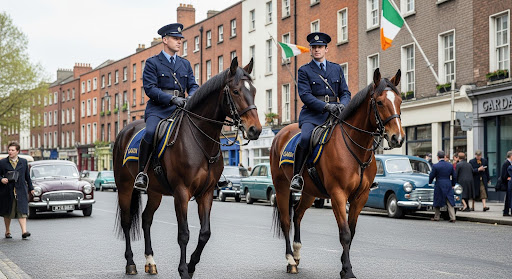Origins: From Colonial Constabulary to National Force
While horse-mounted policing in Ireland dates back to the 18th-century Royal Irish Constabulary, the modern Garda Mounted Unit has a more complex lineage. Following Irish independence in 1922, the newly formed Garda Síochána initially abandoned mounted patrols, partly as a symbolic break from colonial policing methods.
However, pragmatism eventually prevailed over politics. By the mid-1930s, the practical benefits of mounted officers for crowd control and patrolling rural areas led to the experimental reintroduction of horses in limited capacities.
The Official Establishment: 1947
The Garda Mounted Unit was formally established in 1947 and is headquartered at the Phoenix Park in Dublin. The initial unit consisted of just 6 riders and horses, but quickly proved its value both functionally and as a symbol of the modernising force.
Commissioner Michael Staines, the first Garda Commissioner, had initially been reluctant about mounted units, famously stating that the new Gardaí would “succeed not by force of arms but on their moral authority as servants of the people.” Interestingly, the reintroduction of mounted units came to embody this very philosophy – serving as visible, approachable guardians rather than intimidating enforcers.
The Quiet Years: 1950s-1980s
Through the mid-20th century, the Mounted Unit maintained a consistent if modest presence. Their duties primarily centred on ceremonial functions, rural patrols in difficult terrain, and occasional crowd management at sporting events.
During the Troubles, the Mounted Unit faced unique challenges, as horses were sometimes targeted during civil disturbances. This led to enhanced training protocols and protective equipment that remain part of the unit’s standards today.
Modern Renaissance: 1990s Onwards
The 1990s saw a significant expansion of the Mounted Unit as community policing philosophies gained prominence. Research consistently demonstrated that mounted officers dramatically increased positive public interactions – people who would never approach a patrol car would happily engage with mounted Gardaí.
By 1998, the unit had expanded to 14 horses and riders, with specialised training facilities established at Garda Headquarters in Phoenix Park. The modern unit benefits from purpose-built stables, all-weather training arenas, and specialised transport vehicles.
Training and Selection
Not just any Garda can join the Mounted Unit. Selection involves rigorous testing of riding ability, temperament, and physical fitness. Successful candidates undergo a 20-week intensive training course covering everything from advanced horsemanship to public order tactics.
The horses themselves undergo equally selective processes. The unit primarily uses Irish Draughts and Irish Sport Horses – breeds chosen for their calm temperament, intelligence, and stamina. Each horse undergoes approximately 12 months of training before entering active service.
In a charming tradition that connects the force to the community, horses are typically named after Irish rivers – current mounts include Shannon, Liffey, and Slaney.
Modern Roles and Effectiveness
Today’s Mounted Unit fulfils diverse functions:
- High-visibility urban patrols, particularly in Dublin’s shopping districts
- Crowd management at sporting events, concerts, and demonstrations
- Ceremonial duties for state visits and national celebrations
- Searches in rough terrain inaccessible to vehicles
- Community engagement and public relations
Studies conducted by the Garda Analysis Service in 2018 found that areas regularly patrolled by mounted officers saw crime reductions of up to 18% compared to control areas – a testament to their continued relevance in modern policing.
Looking Forward
As we look to the future, the Garda Mounted Unit faces both challenges and opportunities. Climate considerations have led to sustainability initiatives, including eco-friendly stable management and locally-sourced feed programs.
The unit has also embraced technology, with mounted officers now equipped with body cameras and specialised communications equipment. Yet the fundamental appeal remains unchanged – the unique combination of height advantage, mobility, and public approachability that only mounted policing can provide.
Conclusion: Tradition Meets Innovation
The story of the Garda Mounted Unit reflects the larger narrative of Irish policing – a thoughtful balance of tradition and innovation, authority and community service. From its complex origins to its current role as both a practical policing tool and a beloved public symbol, the Mounted Unit embodies the evolving identity of the Garda Síochána itself.
Written by Sean Daly Garda

